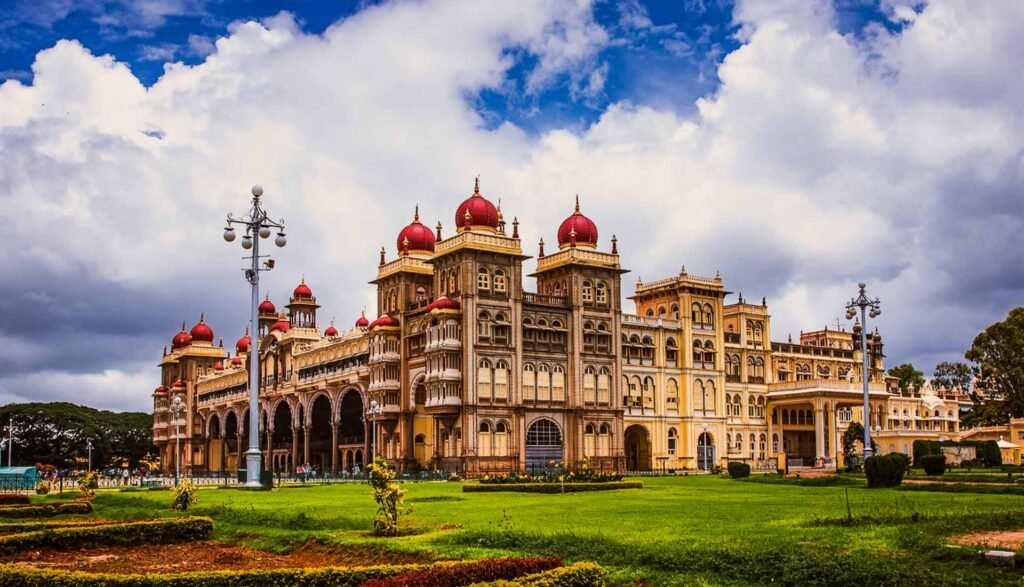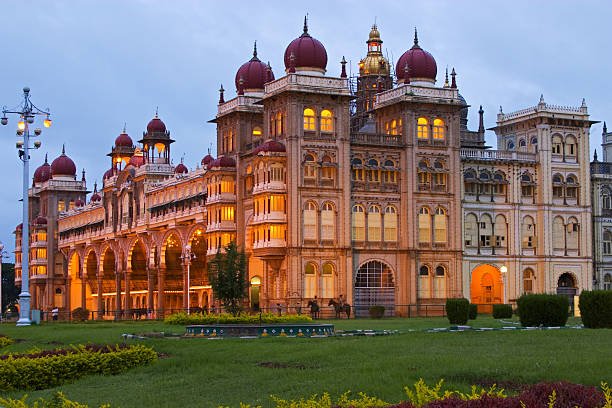This palace has been a silent witness to history for many centuries with its background presenting Wadiyar dynasty kings. It characterizes an integration of various architectural styles. Hence, millions of people visit this place every year, which eventually turns it into one of the most-visited monuments in India.
The Architectural Wonder
Architectural Style
Apart from being typically indicative of Indo-Saracenic architecture, the Mysore Palace generally typifies the architectural styles of various secondary schools, including Hindu, Muslim, Rajput, and Gothic amongst others. This palace is also extremely famous for its highly ornamented interior, the extended courtyard, and the big domes that together create a breathtaking visual effect.
It finds manifestation in the merging of arches, domes, and minarets with sprinklings of detailed carvings and motifs to expose the flamboyancy of life so characteristic of the Wadiyar kings.
It reflects the Dravidian influence in the skillfully worked pillars and arches. The domes and minarets have attained a Mughal touch in their design and construction. The Gothic influence is reflected in lofty windows and vaulted ceilings.
Structural and Layout
Mysore Palace is a wonder of architectural design. The building has an area of 72 acres with an immense plot of a garden space around the edifice. It is a three-story structure comprising a chain of square towers, each surmounted by domes.
Exterior Features
Deep pink domes and one gigantic central arch adorn the outer facade majestically. The fragile-looking facade is done with beautiful arches, overhanging balconies, and deeply set bay windows beset with intrinsic carvings and motifs.
Great Wonder: Marble Domes of the Palace are a great wonder. These and other domes besides the minarets give an imposing look to the building and lend a touch of royalty as well, reflecting the glory of the Wadiyar dynasty.
# Arches and Pillars
The Mysore Palace follows the theme of arches and pillars, not only for structural purposes but as an art in itself. Every arch is intricately carved; each detail speaks of various tales from history and of the cultural background of the region. Similarly, these pillars are magnificent with their detailed carvings and polished surfaces.
# Durbar Hall

This forms one of the major halls in the palace and was, in fact, the courtroom of the Maharaja where ceremonies were executed. Chandeliers with an ornate form, carved wooden ceiling, and stained glass windows form part of the beautification of this great hall.
# Ambavilasa
Another essential part of the private audience is Ambavilasa or Diwan-e-Khas. It contains ivory inlaid doors, gold-plated columns, and especially intricately designed roofs so that it becomes even more magnificent.
Materials Used
The palace of Mysore was made from some of the finest materials in those times, mainly marble, teakwood, and granite. The conjunction of these materials is not only added to their strength in structure but also aesthetic beauty .
History
Mysore Palace – Origin
History can trace the original Mysore Palace back to the 14th century. Constructed by the Wadiyar Dynasty, through the ages it became a victim of several renovations and extensions on account of changing tastes and requirements of its royal occupants.
Wadiyar Dynasty
The developments regarding Mysore Palace have the Wadiyar dynasty acting as its prime mover. A great patron of art and architecture, their contributions can be reflected in each minute detail of the design in the palace.
Contributions to Mysore Palace
Every Maharaja of the Wadiyar dynasty added something to the building: adding new wings, adding ornamental features, or ordering the works of art. It is due to their foresight and patronage that Mysore Palace stands as an architectural marvel of its type.

Rebuilding After the Fire
Due to a terrible fire in 1897, much of the palace came down to ashes. Later on, Maharaja Krishnaraja Wadiyar IV gave this job of rebuilding of the Palace to British architect Henry Irwin. The building standing today -a melting pot of all those architectural styles- came into existence in 1912.
Importance of Mysore Palace
Cultural Significance
The Mysore Palace, as such, is no mere testimony to royalty; it’s an icon to any culture in which it may reside. For hundreds of years, it has formed a part of active life-participating in every major festival and event of the people of Mysore, apart from other rituals.
Royal Heritage
Besides being symbolic of the power, influence, and wealth of this royal dynasty, besides being a chronicler of Wadiyar’s origin into royalty, it stands tall even today to pride for the people of Mysore.
Tourist Delight
Key Attractions
The Mysore Palace has been a treat for the eyes of its visitor as far as art and architecture are concerned. It does contain some of the key attractions like Gombe Thotti or Doll’s Pavilion, Golden Howdah, Royal Portrait Gallery, Kalyana Mantapa or Marriage Hall, and impressive armoury of the palace.
Special Events
The Palace also forms the center of various important events and festivals, one of them being the Dussehra festival that comes every year. During these times, the place brightens up with thousands of lightings that create an atmosphere of enchantment to attract tourists from across the world.
Key Attractions Inside Mysore Palace
The Gombe Thotti (Doll’s Pavilion)
It showcases in this pavilion a repertoire of traditional dolls from all parts of India, with some of these dolls tracing several centuries. Gombe Thotti is an amusing display, especially to children and indeed indicative of the rich cultural legacy within the region.
Golden Howdah
This is a gold-plated seat that the Maharajas used during processions. It weighs approximately 750 kgs. The howdah reflects luxury and skill in craftsmanship.
The Royal Portrait Gallery
The Royal Portrait Gallery contains the portraits of the Wadiyar rulers tracing the history of the dynasty visually. The gallery contains the paintings depicting the major events relating to the history of Mysore.
The Kalyana Mantapa
Kalyana Mantapa is the most elaborately and luxuriously designed chambers in the palace. The marvelous stained glass ceiling with peacock motifs on the floor gives beauty and wealth to every marriage.
Armoury
The Armory consists of a gallery showcasing weapons of swords, spears, and shields that were the armory of the rulers of Wadiyar. A treasury armory speaks about the martial history of the dynasty.
Events and Festivals at Mysore Palace
Dussehra Celebrations
Dussehra is the most identifiable festival of Mysore Palace. The ten-day long festival celebrated with great grandiosity features elephant processions along with different cultural programmes. The entire palace is lighted up with more than 100,000 lights. Importance of Dussehra
Dussehra is considered one of the most major festivals of Mysore because the spirit of this occasion defines the victory of good over evil. This festival has been celebrated for several centuries by the Wadiyar dynasty and is one of the most waited events that take place within the city.
Mythological Significance-Illuminations and Processions
This scenery becomes vibrant with lights on Dussehra. One of the major procession attractions that takes place for this event includes carrying the Golden Howdah, which attracts people all over the world.
Other Major Events
Besides Dussehra, many more cultural events are organized during the year inside the premises, such as classical music concerts, dance events, and various other exhibitions to reflect upon Mysore’s rich culture.
Events all over the Year
It is also a hub for various cultural activities wherein many events keep happening in the palace throughout the year. Such events make Mysore yet another stride towards being the cultural capital of South India.
Visitor Information
Visiting Hours
Mysore Palace opens its gates every day from 10 AM in the morning to 5.30 in the evening. This does look most beautiful at nights when the palace gets partially illuminated.
Price of Entry Tickets
This includes a very nominal entrance fee to the Mysore Palace, and concession is given to children and senior citizens. There are guided tours also for those who want an even better experience in the palace.
Best Time to Visit
October is an ideal time to see Mysore Palace during the celebration of Dussehra. At this time, the light in the palace is amazingly attractive; festivals are vibrant alive here in the city.
Accessibility and Facilities
The entrance to the palace is accessible for people who have disabilities, and for visitors, there are washrooms, a café, and souvenir shops.
Conclusion
Besides being a living wonder of architecture, Mysore Palace itself is a testimony to India’s rich cultural heritage. As fact would have it, it is quite an experience: completely satisfying in its grandeur, historical significance, and cultural implication-all enough to make it worth seeing for any person who would want to delve into the South Indian royal past. Its eternal appeal keeps the visitors spellbound as one of the most preferred monuments in the country.




